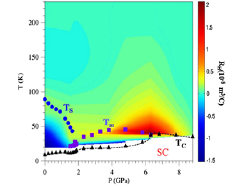High-Tc Superconductivity in FeSe at High Pressure: Dominant Hole Carriers and Enhanced Spin Fluctuations
Uwatoko Group
The Fermi surface (FS) topology and its interplay with magnetism have been considered key ingredients in understanding the mechanism of the iron-based high-Tc superconductors. For the FeAs-based superconductors, the FS typically consists of hole and electron pockets near the Brillouin zone center and corners, respectively. As such, an interband scattering between the hole and electron pockets has been proposed as an important mechanism for electron pairing in the iron-based superconductors, leading to an s± pairing state favored by the antiferromagnetic fluctuations. This picture, however, is challenged by the observed distinct FS topology in the FeSe-derived high-Tc (> 30 K) superconductors, including AxFe2-ySe2 (A = K, Cs, Rb, Tl), (Li,Fe)OHFeSe, and monolayer FeSe film, in which only the electron pockets are observed near the Fermi level. Therefore, the distinct FS topology between FeAs- and FeSe-based materials has challenged current theories on a unified understanding of the mechanism of iron-based superconductors.

Fig. 1. Phase diagram and Hall coefficient of FeSe. Temperature-pressure phase diagram of FeSe is superimposed by a contour plot of Hall coefficient RH, which is defined as the field derivative of ρxy, RH ≡ dρxy/dH, at the zero-field limit at each temperature and pressure. The structural (nematic) transition (Ts), pressure-induced magnetic transition (Tm), and superconducting (SC) transition (Tc) have been determined by the resistivity measurements under pressure [1]. The dashed curve is a guide for the eyes.
In contrast to electron-doping approaches, the application of high pressure does not introduce extra electron carriers, yet can still enhance Tc of bulk FeSe from 8 K to 38 K near 6 GPa. Our recent high-pressure study on FeSe has shown explicitly that the optimal Tc is achieved when the long-range antiferromagnetic order just vanishes, reminiscent of the situations seen frequently in the FeAs-based superconductors [1]. To make this connection, it is important to have information about the evolution of the FS under high pressure—a regime in which ARPES experiments are impractical, and where quantum oscillation measurements are challenging. Alternatively, we measured the Hall effect under hydrostatic pressures up to 8.8 GPa with the cubic anvil cell technique to gain further insights into the electronic structure evolution of FeSe at high pressure.
The main results are summarized in the phase diagram of Fig. 1. Our results demonstrate that the electrical transport properties of FeSe at high pressures with Tcmax = 38.3 K are dominated by the hole carriers, which is in contrast with the known FeSe-derived high-Tc superconductors that are usually heavily electron doped. In addition, we observed an enhancement of Hall coefficient RH near the critical pressure where the optimal Tc is realized with a simultaneous suppression of the long-range magnetic order. This implies a strong reconstruction of the Fermi surface due to antiferromagnetic order, consistent with the ordering pattern driven by interband scattering. Importantly, their results show a continuous path to high-Tc superconductivity in chalcogenides without electron doping.
Thus, our present work can be considered as a significant step forward in making a unified picture on the current understanding of iron-based high-Tc superconductors, specifically by demonstrating that high Tc in FeSe can be achieved with an electronic structure and other characteristics similar to the FeAs-based high-Tc superconductors.
References
- [1] J. P. Sun, K. Matsuura, G. Z. Ye, Y. Mizukami, M. Shimozawa, K. Matsubayashi, M. Yamashita, T. Watashige, S. Kasahara, Y. Matsuda, J.-Q. Yan, B.C. Sales, Y. Uwatoko, J.-G. Cheng, and T. Shibauchi, Nature Commun. 7, 12146 (2016).
- [2] J. P. Sun, G. Z. Ye, P. Shahi, J.-Q. Yan, K. Matsuura, H. Kontani, G. M. Zhang, Q. Zhou, B. C. Sales, T. Shibauchi, Y. Uwatoko, D. J. Singh, and J.-G. Cheng, Phys. Rev. Lett. 118, 147004 (2017).
